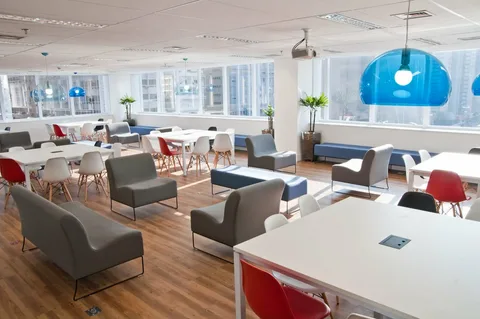The modern workplace is undergoing a significant transformation. With the rise of remote work, freelancing, and startups, traditional office environments are being reimagined. Shared office spaces, also known as co-working spaces, have emerged as a popular solution, offering flexibility, community, and cost-effectiveness. Whether you’re a freelancer seeking a professional environment, a startup looking for scalable office options, or a corporation aiming to foster innovation, shared office spaces might be the perfect fit.
What Are Shared Office Spaces?
Shared office spaces are communal work environments where individuals from different companies or professions work alongside each other. These spaces provide all the amenities of a traditional office—desks, meeting rooms, high-speed internet, and more—without the long-term commitment or overhead costs associated with leasing a private office.
Benefits of Shared Office Spaces
- Flexibility
- Short-Term Leases: Rent a desk or office on a daily, monthly, or yearly basis.
- Scalable Options: Easily adjust your space needs as your team grows or shrinks.
- Cost-Effective
- Lower Overheads: Share costs for utilities, maintenance, and amenities.
- Access to Premium Facilities: Enjoy high-end office amenities without the hefty price tag.
- Networking Opportunities
- Community Environment: Work alongside like-minded professionals from various industries.
- Collaborative Atmosphere: Opportunities for partnerships, mentorships, and collaborations.
- Enhanced Productivity
- Professional Setting: A dedicated workspace can improve focus and efficiency.
- Amenities and Services: Access to meeting rooms, printers, and administrative support.
- Location Advantages
- Prime Locations: Many shared spaces are situated in central, accessible areas.
- Global Access: Some providers offer access to multiple locations worldwide.
Types of Shared Office Spaces
- Hot Desking
- First-come, first-served seating in a communal area.
- Ideal for freelancers or those needing occasional workspace.
- Dedicated Desks
- A specific desk reserved for your use.
- Suitable for individuals needing a consistent workspace.
- Private Offices
- Enclosed offices within the shared space.
- Perfect for small teams or those requiring privacy.
- Virtual Offices
- Access to a professional business address and mail handling.
- Beneficial for remote businesses needing a physical presence.
- Meeting and Event Spaces
- Rooms available for booking on an as-needed basis.
- Useful for presentations, workshops, or client meetings.
How to Choose the Right Shared Office Space
- Assess Your Needs
- Space Requirements: Determine how much space you need now and in the near future.
- Amenities: Identify must-have features like high-speed internet, kitchen facilities, or parking.
- Consider the Location
- Accessibility: Proximity to public transport, clients, or team members.
- Neighborhood Vibe: The local area’s atmosphere can impact your work culture.
- Budget Accordingly
- Transparent Costs: Look for spaces with clear pricing structures.
- Hidden Fees: Inquire about additional costs for services or amenities.
- Visit the Space
- Tour the Facility: Get a feel for the environment and community.
- Test the Amenities: Ensure that the internet speed and other facilities meet your standards.
- Check Community and Culture
- Networking Potential: A vibrant community can offer valuable connections.
- Cultural Fit: Align with spaces that match your company’s values and work style.
The Impact of Shared Office Spaces on Business Growth
- Startup Acceleration: Access to resources and mentorship opportunities can accelerate growth.
- Talent Attraction: Modern, flexible work environments can attract top talent.
- Innovation Boost: Collaboration with diverse professionals can spark innovative ideas.
- Market Expansion: Global co-working networks allow businesses to explore new markets with ease.
Future Trends in Shared Office Spaces
- Niche Co-Working Spaces
- Industry-Specific: Spaces tailored for tech, design, health, etc.
- Community-Focused: Emphasis on building tight-knit professional communities.
- Enhanced Health and Safety Measures
- Post-Pandemic Adjustments: Increased sanitation, social distancing layouts, and touchless technologies.
- Technology Integration
- Smart Offices: IoT devices for lighting, climate control, and room bookings.
- Virtual Collaboration Tools: Enhanced support for remote and hybrid teams.
- Sustainability Initiatives
- Green Buildings: Eco-friendly designs and energy-efficient operations.
- Wellness Programs: Incorporating spaces for relaxation and wellness activities.
Tips for Maximizing Your Shared Office Space Experience
- Engage with the Community
- Attend networking events and workshops.
- Participate in community forums or social groups.
- Maintain Professionalism
- Respect shared spaces and adhere to community guidelines.
- Keep your workspace tidy and be considerate of noise levels.
- Leverage Available Resources
- Utilize on-site support staff for administrative tasks.
- Take advantage of member benefits like discounts or partner services.
- Provide Feedback
- Share your experiences with management to improve services.
- Suggest ideas for events or amenities that could benefit the community.
Conclusion
Shared office spaces represent a significant shift in how we perceive the workplace. They offer a flexible, cost-effective, and community-driven environment that caters to the evolving needs of today’s workforce. By choosing the right space and actively engaging with the community, businesses and individuals can reap numerous benefits that extend beyond just a place to work.
Whether you’re an entrepreneur launching a new venture, a remote worker seeking social interaction, or a corporation exploring innovative ways to operate, shared office spaces provide a dynamic and adaptable solution. Embrace the future of work by exploring the possibilities that co-working environments have to offer.
